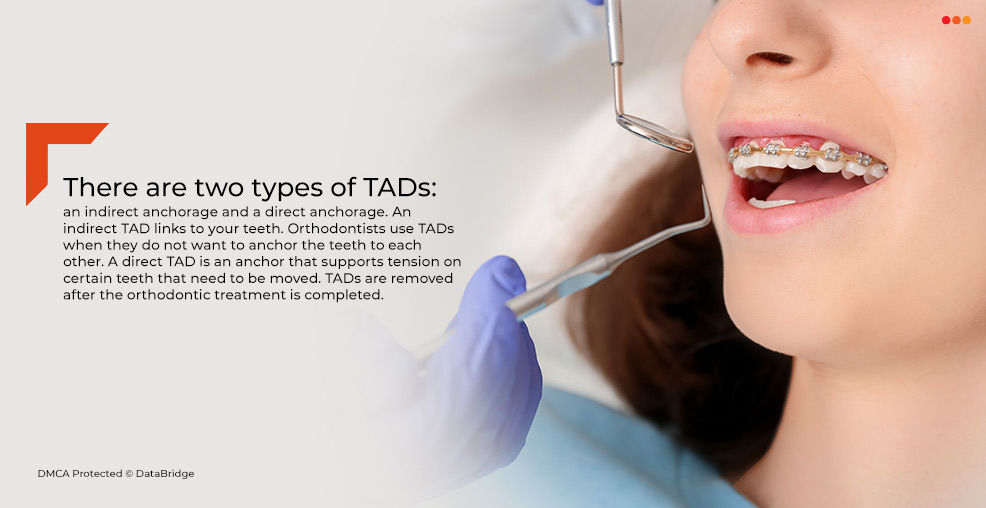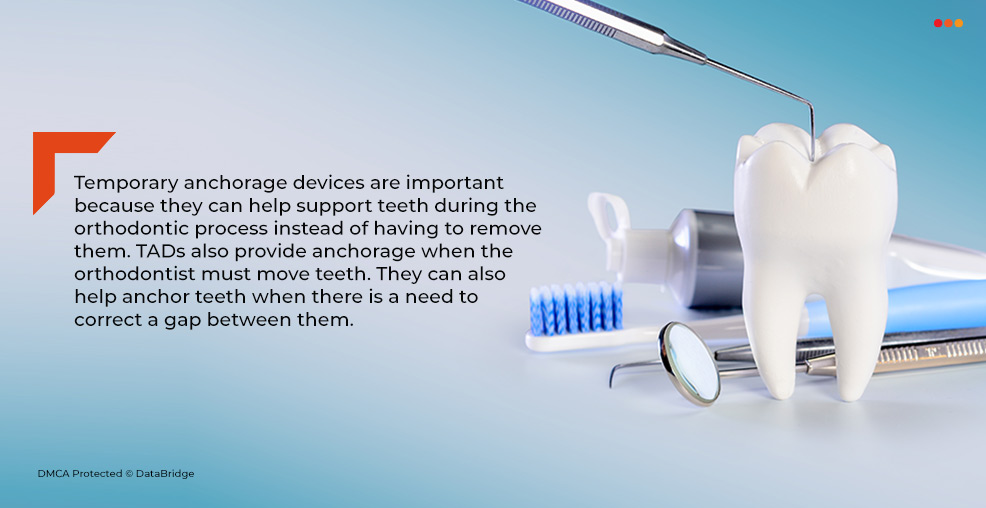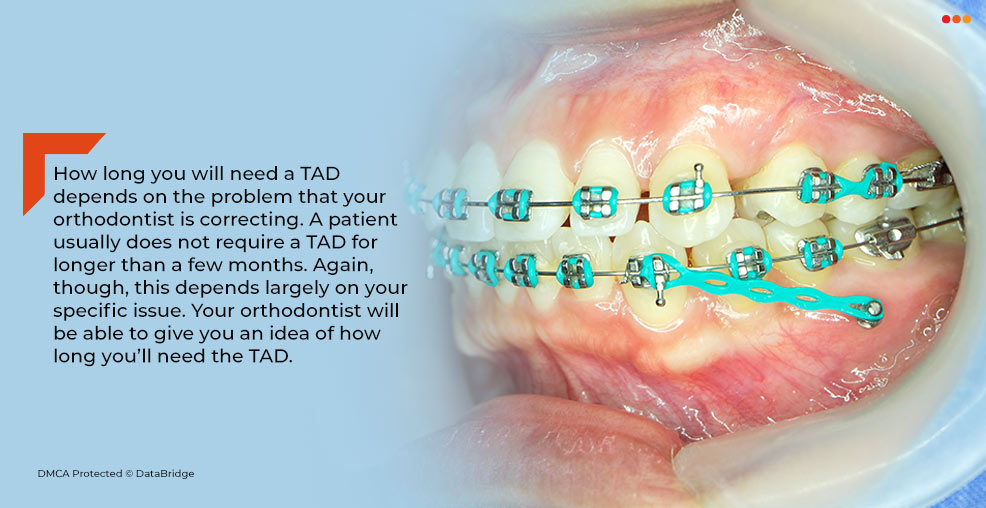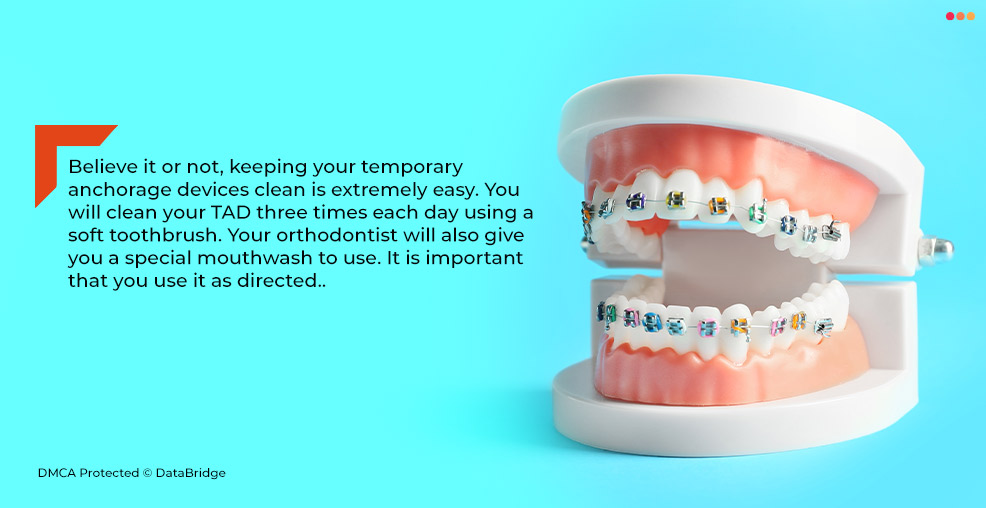Orthodontists are used to controlling anchoring utilizing teeth and supplementary appliances, both intraoral and extraoral. These approaches have limitations since getting outcomes that match our lofty objectives is frequently challenging. Numerous case reports have recently surfaced in the orthodontic literature demonstrating the potential for overcoming anchorage limitations through temporary anchorage devices, which are biocompatible devices anchored to bone for moving teeth and removed following treatment.
A Brief Introduction
In order to provide orthodontic anchorage, temporary anchorage devices (TADs) are often mini-screws inserted into the extra-alveolar or alveolar bone. This device's intended removal after it has served its purpose in the treatment plan is a defining feature.
Little titanium anchors, known as temporary anchoring devices, or TADs, are used in some orthodontic situations to help move teeth more quickly, effectively, and comfortably. TADs can be used instead of headgear or in conjunction with braces. The gum tissue and jaw surrounding where the TAD will be implanted are numbed with a strong anesthetic. The TAD will be carefully inserted into the gum tissue and securely into the jawbone once the area has become numb.
A TAD is placed quickly and might be done before you know it. One may feel a little pressure while the doctor inserts the TAD, but after a day, they won't be able to feel it anymore. TAD is taken out when therapy is finished or it is no longer necessary to straighten teeth. A TAD is easily removed, and the surgery only takes a short while. In orthodontics, implants are now among the most trustworthy types of anchoring. An orthodontist surgically attaches or inserts alloplastic implants into the jawbone. The field of orthodontics has undergone a revolution thanks to the development of miniature implants. Temporary anchoring devices are one type of such miniature implant.
Features of Temporary Anchoring Devices (TADs)
- Temporary anchorage devices (TAD) are biocompatible devices attached to the bone to allow tooth movement. They accomplish this by either supporting the teeth used as anchorage points (such as the "reactive unit") or by preventing the need for such a reactive unit in the first place.
- These tiny implant devices can be attached to the bone biochemically (via a process known as "Osseo integration") or mechanically (through cortical stabilization).
- These TADs can also be placed in various jaw regions, depending on the anchorage and movement required. Following treatment, these devices are simply removed from the mouth.
- You might be wondering how much they cost. A TAD will typically cost between $300 and $600.
The Use of Temporary Anchoring Devices (TADs)
The Food and Drug Administration granted temporary anchoring devices, or TADs, approval for use in orthodontics in 2004. Since then, they have been successfully applied to treat patients efficiently. Although "temporary anchorage device" may sound strange, this item is just a tiny titanium mini screw. Since it is bio-inert, titanium is used. This implies that it won't cause swelling near the site of its insertion or leak dangerous substances into the gums. Orthodontic mini implants and orthodontic mini-screws are two other names that are frequently used to refer to TADs.
Global single tooth implants and dental bridges market was valued at USD 5,460.29 million in 2021 and is expected to reach USD 10,031.99 million by 2029, registering a CAGR of 7.90% during the forecast period of 2022-2029. The single tooth implants and dental bridges market is segmented on the basis of product, type and material. Europe dominates the single tooth implants and dental bridges market because of the presence of major and local dental manufacturing companies within the region.
To learn more about the study, visit: https://www.databridgemarketresearch.com/reports/global-single-tooth-implants-and-dental-bridges-market
TADs are only used in a small portion of orthodontic cases, but when they are appropriate, they can significantly alter outcomes. TADs are introduced into the alveolar (jaw) bone via the gums at a safe distance from the roots of neighboring teeth. This creates what is an anchor point within the mouth. Without adversely impacting the position of neighboring teeth or the bite, they enable the orthodontist to either prevent undesirable tooth movement or achieve desired tooth movement. Additionally, TADs enable specific tooth movements that were previously only accessible through jaw surgery.
TADs are fastened to particular teeth, braces, or an orthodontic tool that is being used. The TAD system and braces move teeth gently into the desired ultimate position by applying small, consistent forces. In some cases, TADs can be utilized to accelerate tooth movement, while in other cases, they can shift teeth more subtly than headgear ever could. They are occasionally used in place of elastic bands. These cutting-edge micro screws are frequently utilized in place of more invasive procedures.
TADs may be utilized to move nearby teeth into permanent tooth locations for older children or adults who lack permanent teeth (either naturally or as a result of prior decay). This may save the need for pricey dental implants or bridges and a lifetime of dental care. Treatment of "gummy" smiles without the necessity for jaw surgery has been one of the most frequently used applications for TAD.
The Process of Using Temporary Anchoring Devices (TADs)
A patient might find solace in the knowledge that placing temporary anchorage devices inside the mouth is a rapid, non-invasive operation that is also comparatively painless if an orthodontist advises it.
The area will be numbed after a topical, gel-like anesthetic is applied to the gums in the region where the TAD(s) will be positioned. Due to the potent gel numbing agent, needle injections are typically unnecessary. The tiny screws will then be carefully and gently inserted into position by the orthodontist. During application, the patient should only experience pressure—not pain. The entire procedure is finished quickly, usually in a few minutes.
Temporary anchorage devices are used to provide stable anchorage for protruding incisors, deep bites, open bites, and abnormally erupted molars. Anchorage is important in these situations because a fine line between applied force and gradual movement must be done safely while keeping the patient's health in mind. The force provided by the temporary anchorage devices moves the teeth, gums, and other ligaments, but it also provides a fixed point for the force to be applied to move the teeth into place. These can eventually replace the need for elastics and headgear, but this is not always the case.
Global dental aligners market is expected to reach USD 10,377.52 million by 2028 from USD 3,643.91 million in 2020, growing with a CAGR of 14.4% in the forecast period of 2021 to 2028. The increasing demand for aesthetic appearance has further propelled the demand for orthodontic treatment worldwide. Thus, the growing prevalence of malocclusion drives the growth of the dental aligners market. The demand for the dental aligners market is increasing and market players has a strong focus on developing and launching new products in the dental aligners market. These strategic initiatives by market players are escalating the growth of the dental aligners market.
To learn more about the study, visit: https://www.databridgemarketresearch.com/reports/global-dental-aligners-market
These devices typically provide a pushing or pulling force that eliminates the need to use other teeth in the mouth to provide that force. They work to stabilize the affected teeth and move them gradually over a shorter period of time. However, depending on the severity of the misalignment, other devices such as headgear, elastics, and even surgery may be required.
Benefits of TADs
Although temporary anchorage appliances are among the least discussed orthodontic appliances available, they can be a great option for individuals with misaligned teeth who want to experience moderate tooth movement. These temporary gadgets, as their name suggests, are installed for a brief period of time before being taken out. TADs provide a sturdy foundation for the teeth as they eventually erupt into position. What are they exactly, and why are they significant? For patients with severe malocclusion, temporary anchorage devices can be crucial in addition to braces.
The malocclusion market is expected to gain market growth in the forecast period of 2021 to 2028. Data Bridge Market Research analyses that the market is growing with the CAGR of 7.07% in the forecast period of 2021 to 2028 and is expected to reach USD 37467.30 million by 2028. The growing number of incidences of malocclusion will help in escalating the growth of the malocclusion market. Malocclusion can also be referred as the misalignment of teeth that can lead to severe oral health complexities.
To learn more about the study, visit: https://www.databridgemarketresearch.com/reports/global-malocclusion-market
Some other benefits include:
- Painless placement- The length of temporary anchorage devices is typically 1.5 millimeters. A local anesthetic, either gel or injections, is used to numb the area and prepare it for the device before placing it in the mouth.
- Reliable and predictable results- Over the last ten years, orthodontists have relied on temporary anchorage devices to treat mild and moderate tooth misalignment cases.
- Controlled tooth movement- These devices also help to prevent teeth from moving in undesirable directions and are an excellent way to control movement during orthodontic treatment.
- Simple at-home care- These devices are simple to clean and can be cared for at home with brushing and flossing.
- Hidden out of sight- Patients concerned about their appearance should not be concerned because they are practically hidden from normal sight.
- Simple removal procedure- The removal procedure is as simple as the preparation and painless.
- Straighten teeth more quickly- Temporary anchorage devices straighten teeth faster than alternative methods, such as braces and clear aligners, and can be easily removed after a few months.
The Future of TADs
Temporary anchorage devices, which were recently introduced into the realm of orthodontics, have helped orthodontists speed up treatment time and maintain close control over tooth movement more effectively. All of this is now accomplished with minimal discomfort to the patient. However, before the approval of TADs, less effective methods were used. One of these methods was to use other teeth as anchor points.
This traditional method could cause other teeth to move unintentionally or in an unfavorable direction to the bite. In other cases, headgear was worn as an anchorage device. This was not always successful due to the patient's responsibility to wear their headgear as consistently as possible. Fortunately, the innovative TADs require less patient participation during treatment, allowing teeth to be moved more accurately, always, and comfortably than ever before. The introduction of temporary anchorage devices into the field of orthodontics as an alternative to standard anchorage methods demonstrated that it was possible to overcome the anchorage's previous limitations.
Numerous case studies about the promise of this new technology have emerged since the early 2000s, attesting to this fact. Perhaps the most significant contribution temporary anchorage devices have made to the field of orthodontics is the ability to achieve "infinite anchorage," which means that no movement (i.e. no anchorage loss) occurs during treatment.













